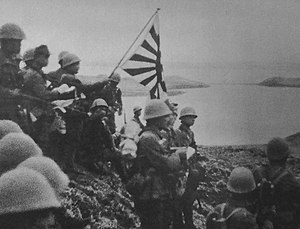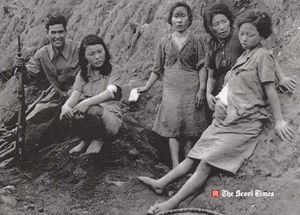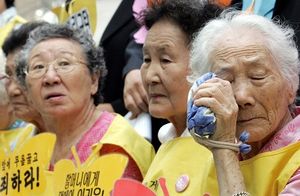GRSJ224/Comfort Women during the Annexation of Korea
During 1910 to 1945, Korea was attacked by Japan and was completely under the rule of the Japanese Empire. Much of Korea's land, resources, and Koreans themselves were abused and forced to help and fight for the rule of Japan. Among the many ways that Korean culture, people, and land were used, Korean women, as well as many other women from the surrounding countries, were forced to provide "comfort" for the soldiers and were sexually abused, raped, assaulted, and died as a result of being forced as sex slaves.
Beginning of the Annexation of Korea

In the early 1900’s, the annexation of Korea occurred through a series of invasions and forced treaties in which Japan had created for Korea in order to lose control over their own government. The start of Japan’s control began gradually but was most evident during the Russo-Japanese War in 1904. Starting the year 1904 and onwards, Korea was forced through threats to sign five treaties that ultimately led to their annexation [2]. The first treaty was called the Japan-Korea Protocol which allowed the Japanese military to use Korea’s land for military bases. The second and third treaties were the 1st Japan-Korea Agreement and the Eulsa Treaty which were signed in 1904 and 1905. The two treaties allowed Japan to control the advisors in Korea’s government and take their diplomatic rights away [2]. After the fourth treaty, Japan-Korea Treaty of 1907 and fifth treaty, Japan-Korea Annexation treaty, Korea was annexed and no longer their own independent country.
Throughout the duration of the signing of the five treaties, approximately 2,819 battles occurred in which the Japanese military army and the Righteous Army, an army in support of the freedom for Korea, fought [3]. From 1907 to 1910, approximately 140,000 Righteous Army soldiers fought and 17,688 were killed [3]. After 1910, Korea was officially under the complete rule of Japan.
Treatment Towards Women

During the period of the annexation of Korea, Korean civilians were forced to fight for the Japanese ruling and be rid of their identity, culture, and language. Approximately 200,000 historical artifacts and items were purposefully destroyed by Japan and 725, 000 Korean civilians were forced to move and do laborious work for the country with a total of 5, 400, 000 Koreans contributing, from different sectors, some form of help for the rule of Japan by 1945 [5][6]. Among the thousands of people, many Korean women were forced to be sex slaves, also known as “comfort women”, which involved getting raped, working at brothels at various military bases, and being forced to provide other labor services. Until 1945, approximately 200, 000 women were used as sex slaves for the Japanese military with the majority of women being Korean [7]. Other than Korean women, SouthEast Asian and Chinese women who were also forced to be "comfort women" [8]. The mentioned numbers may be higher but Japanese officials burned documents relating to these historical events by the end of 1945 [8].
Kidnapping and Deception
The process of recruiting women to be “comfort women” were mainly kidnapping and deceiving them of getting a secure and exceptionally "nice" job[7]. One scenario would be receiving a nursing job, being stationed at a military base, and suddenly being forced to be a sex slave [8].
Kimiko Kaneda's Testimony [9]:
Kaneda had a Korean father and a Japanese mother. While travelling, she had hopes of gaining better employment and having a more stable life. Based on a recommendation, she travelled from Seoul to a Japanese family’s house to work as a housemaid. However, she was tricked and the train had led her to a station in which she was forced to be a sex slave, otherwise known as a "comfort woman". As a result of refusing to have sexual intercourse with one soldier, her wrist was broken and she was stabbed with a bayonet in the chest. Kaneda survived until the end of Korea’s annexation but struggled with drug addiction in order to cope with her past and her damaged reproductive health. In 2005, she passed away.[9]
Sexual Abuse, Violence, and Reproductive Health in Brothels

The comfort women would experience sexual abuse, assault, and violence often due to the nature of their forced work. Based on testimonies, comfort women were repeatedly raped without having breaks and were not given many days off [8][9]. Additionally, according to many testimonies, women were trapped in buildings and forced to do both labour and provide sexual services such as Maria Rosa Henson who was confined in a house to provide both services after being tricked with a false job offer [9][11]. Testimonies, such as Kimiko Kaneda’s, showcase the injuries that arise due to not complying to the duties of a comfort woman. As a result of the treatment towards the women in the "comfort stations", their reproductive health were put at risk and had extremely high chances of receiving sexually transmitted diseases [8]. Due to the abuse, poor reproductive health care, and mistreatment amidst areas of extreme war and violence, 90% of the comfort women died before the end of the war and those who survived could no longer bear children due to damaged wombs or diseases [8][12].
Ending of Korea's Annexation
On August 15, 1945, Japan no longer held control over Korea and Korea was back to being its own independent country. However, due to the condition and nature of the war, Korea was extremely unstable [5]. Shortly after the freedom of Korea, the country was split into North and South Korea with expectations that it would be united very soon, which was not the case due to the Korean War[5].
Despite the annexation of Korea being over, "comfort women" were still forced to work and provide sexual services. The United States allowed the operation and system of sex slaves to be used by soldiers, including American sailors and workers, past the end of World War II. Eventually the sex slave system stopped in 1946 [8].
Justice, Controversy, and Accountability
The justice for the Korean population has been minimal due to the denials of harm done by the Japanese government and the irreversible damage to Korea’s people and culture. The past Japanese prime minister, Ikeda Hayato, stated that there were no such “wrongdoings committed by Japan” during and past Korea’s annexation [13]. Although the Japanese government has apologized after Hayato’s statement and stated that the annexation of Korea was “morally unjustifiable”, they still claim that it was based on legal grounds due to the early 1900's treaties [14]. However, there is proof that much of the treaties were not done properly and would not be legal. Evidence shows that during the processing of the fifth treaty, Emperor Sunjong never signed the Korea Annexation Treaty as stated in his will despite the Japanese government treating as though he had and continuing with the annexation regardless [14][2].
As for the justice of the thousands of women forced into being sex slaves, there is still no satisfying solution. There has been a past agreement of Japan acknowledging and paying 8.3 million dollars in exchange for a statue to be taken down in Seoul – a powerful statue that represents the “comfort women” and their traumatizing experiences as sex slaves in Japan's rule of Korea [15]. Due to the request of removing a statue with such representation and meaning, it sparked controversy and only continued the open conversation of "comfort women" and the search for justice and accountability of many soldiers' and governments' actions even more.
- ↑ Taylor, Adam (June 2015). "Japan has a flag problem, too". The Washington Post.
- ↑ Jump up to: 2.0 2.1 2.2 Chinoh, Chu (Winter 2011). "Korean Perceptions of Japan during the Great Han Empire and the Japanese Annexation of Korea". Korea Journal.
- ↑ Jump up to: 3.0 3.1 "4-1 What is the History of the Annexation of Korea by Japan?". Fight For Justice.
- ↑ "U.S. Troops used Japanese Brothels After WWII". NBC News. April 2007.
- ↑ Jump up to: 5.0 5.1 5.2 Blakemore, Erin (February 2018). "How Japan Took Control of Korea". History.
- ↑ C, Peter. "Korea". World War II Database.
- ↑ Jump up to: 7.0 7.1 Seaton, Philip (August 2006). "Reporting the 'comfort women' issue, 1991–1992: Japan's contested war memories in the national press". Japanese Studies.
- ↑ Jump up to: 8.0 8.1 8.2 8.3 8.4 8.5 8.6 Blakemore, Erin (February 2018). "The Brutal History of Japan's 'Comfort Women'". History.
- ↑ Jump up to: 9.0 9.1 9.2 9.3 "Testimonies of the Victims". The Comfort Women Issue and Asian Women's Fund.
- ↑ "U.S. Troops used Japanese Brothels After WWII". NBC News. April 2007.
- ↑ "Women made to be Comfort Women - Philippines". The Comfort Women Issue and Asian Women's Fund.
- ↑ Banks, Grace (September 2017). "South Korea: New generation joins 'comfort women' fight".
- ↑ Horowitz, Shale (April 2016). "South Korea and Japan since World War II: Between Ideological Discord and Pragmatic Cooperation*". Pacific Focus.
- ↑ Jump up to: 14.0 14.1 Park, Pae-Keun (January 2010). "Discussions Concerning the Legality of the 1910 "Annexation" of Korea by Japan". Korea Journal. 50.
- ↑ "Japan / S. Korea: "The long awaited apology to 'comfort women' victims is yet to come" – UN rights experts".


